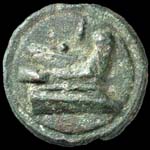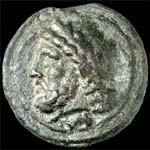
The as, or more precisely the aes grave (or aes librale), was the first Roman coin. The value of the bronze contained in the coin was linked to the Roman unit of weight , having an initial weight equal to a Latin pound (the "libra", equal to 273 g), then becoming a Roman pound (327 g).
Initially the as was produced as cast coinage, then transformed in hammered coinage. The first series of the as was the Janus-Mercury series, whose name derives from the images of the two divinities reported on the coin, in addition to the mark "I" as the value of the coin of "one as".
In the republican era, the prow series in bronze was introduced (around 225 B.C., in concomitance with the introduction of the quadrigatus). The name of the series comes from the bow of a ship depicted on the reverse.


The last series of the "aes grave" was the "wheel" one, named after the six spoked wheel depicted on the reverse.
Besides the as, a certain number of fractions were produced organized in a duodecimal system linked to the uncia, one-twelfth of a libra (pound); in the following table the fractions of the as are shown, with their image on the front and the mark used to display the value related to the as and the uncia:
| Coin | Ratio with the as | Ratio with the ounce | Picture | Mark |
|---|---|---|---|---|
| As | 1 as | 12 ounces | Janus | I |
| Semis | 1/2 as | 6 ounces | Saturn | S |
| Triens | 1/3 as | 4 ounces | Minerva | four pellets |
| Quadrans | 1/4 as | 3 ounces | Hercules | three pellets |
| Sextans | 1/6 as | 2 ounces | Mercury | two pellets |
| Uncia | 1/12 as | 1 ounce | Roma | one pellet |
The semis (pl. semisses, that literally means the half) was worth the half of one as. During the Roman Republic, the semis was marked by the 'S' or by 6 pellets (showing a theoretical weight of the 6 unciae). The bronze coin was characterized by the image of the god Saturn on the front and by the prow of a ship on the reverse. Initially it was a cast coin as all the other Republican Roman bronzes; it began to be struck with hammer just before the Second Punic War (218-204 B.C.). The coin has rarely been issued during the Roman empire and it was dismissed at the time of Hadrian (117-138 AD). In the Byzantine coinage, the term was referred to coins were worth one half of the solidus.


The triens (pl. trientes) was worth one third of the as, so 4 ounces. The most common type of triens was Minerva, with four globules on the front and the prow of a galley to the reverse. It was not a common denomination and it was minted for the last time in 89 B.C.. A cast triens also exists, with a Lightning on the front and a dolphin on the reverse.


The quadrans (literally "a quarter") was a Roman bronze coin that was worth 1/4 of one as. The quadrans was used since the initial melted bronze coins of the Roman Republic and it was characterized by three pellets (representatives of three ounces) as indication of value. On the right the head of Hercules was depicted, while the reverse there was the usual galley prow. After the adoption of the uncial system in 90 BC, the quadrant was the coin of lower value to be coined, continuing to be coined until the time of Antoninus Pius (138-161 AD).


The sextans was the submultiple equal to one sixth of the as, then 2 ounces. On the obverse of the bronze coin was represented Mercury, in addition to the two cells pellets representing the value, while on the reverse he had the usual galley prow, although in the coinage of central Italy there was a great variety of images, such as shells, caduceus, tridents, cornucopias, and cicadas.


The uncia (plural unciae) it had a value of a twelfth of as and a theoretical weight of around 27 grams. The image most used for the front after 240 BC was to Rome with his helmet. One pellet indicates its value.
During the Empire, an ounce was briefly also minted under Trajan (98-117) and Hadrian (117-138). In this phase, the diameter of the coin was of 11-14 mm and weighed ca. 0,8-1,2 grams. On the obverse there was the head of the emperor without any inscription, while on the reverse there was the initial "SC" (Senatus Consulto).


Other bronze coins coined in Rome and linked to the as system were:
As far as the multiples of the as, the following table shows the main denominations:
| Coin | Ratio with the as | Ratio with the denarius |
|---|---|---|
| As | 1 | |
| Dupondius | 2 | |
| Sestertius | 2,5 | 1/4 |
| Tressis | 3 | |
| Quadrusse | 4 | |
| Quincussis | 5 | 1/2 |
| Decussis or Denarius | 10 |
The dupondius (two pounds) had a value of 2
asses (1/2 of a sestertius or 1/8 of denarius). It was introduced during the
Roman Republic as melted coin of great dimensions, even if usually it weighed less than two pounds. The coin introduced
the head of Rome to obverse and a six-spoked wheel to the reverse.
With the monetary reform of
Augustus in 23 BC, the dupondius was struck in Orichalcum, a
golden-colored bronze alloy, while the smaller denominations
were produced in reddish copper.
To distinguish the dupondius by the
as, having a similar size after the
monetary reform of Nero
in 66 AD, a radiant crown for the emperor was adopted. The use of a radiant crown
to point out a double value was also used also in the antoniniano
(double denarius) and in the double sesterzio. The dupondio was minted up to
the end of the III century.
The tressis, having a value of 3 asses, was marked by the sign III (three).
The decussis, having a value of 10 asses, was marked by the sign of the value X (ten). Adopted after the semi-libral standard for the as, was minted in a very limited number with a sample of 1107 g. at the Museo Nazionale Romano in Rome. The coin used as 10 ases was more commonly the denarius, in silver.
The value of the as progressively reduced in time, adopting the value of its fractions; the principal phases of the as were:
With the progressive reduction of the weight of the as, the coins was nomore cast , but struck. The use of bronze to mint coins ended in 79 BC.
After the monetary reform of Augustus in the 23 BC, the weight of the as was further reduced to 1/30 of pound, equal to 10,91 g. It was struck on pure red copper rather than on bronze.


Given the responsibility of the senate on the coinage in copper, the coins introduced on the reverse the initials "SC", meaning Senatus Consulto. Concerning the multiples of the as, the sesterzio (4 asses, with the value of the denarius becaming sixteen asses) and the dupondio (2 asses) were produced in oricalco.
The as was produced up to the III century AD and it was the lower value coin during the Roman Empire while the semisse and the quadrant were dismissed at the time of Marcus Aurelius.
Since the III century AD, assarion (plural assaria) was the name of the Roman bronze coin in the oriental provinces using Greek language.
Given the difficulty to obtain information about the coins of the eastern provinces in the latter part of the empire and the differences from province to province, a methodology to classify bronze coins in four levels has been adopted, according to the scale reported in the following table:
| Coin | Diameter | Weight |
|---|---|---|
| Æ1 | 28mm | 8-9g |
| Æ2 | 22-25mm | 4-5g |
| Æ3 | 15-18mm | 1,5-2,5g |
| Æ4 | 8-12mm | 1,15g |
where the symbol "Æ" means aes. Subsequently, this system has been generalized in the form Æxx, where the value xx points out the diameter in millimeters of the coin.